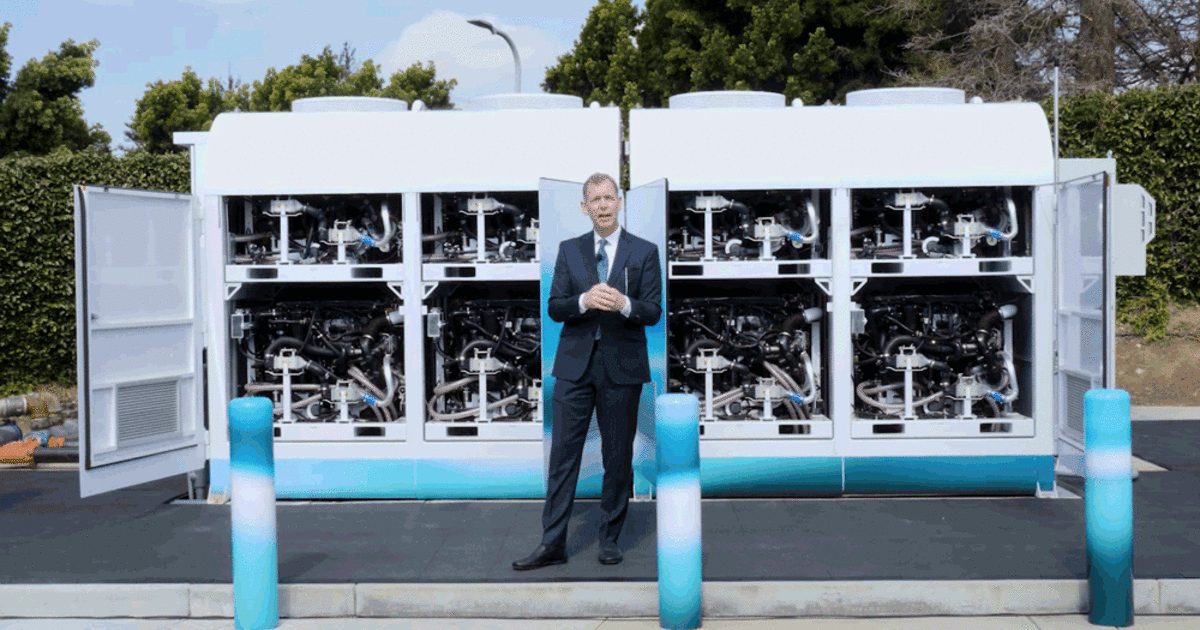
Honda Motor Co., which plans to launch a new U.S.-made fuel cell vehicle next year, now intends to use the technology on a second front: powering business offices and factories.
The Japanese automaker began operating a fuel cell backup power station last week for the data center at its U.S. corporate headquarters in Torrance, Calif., to demonstrate how the technology can serve as a cleaner alternative to diesel generators.
Honda said the California power station is a proof of concept that will help carve its path to zero emissions. The automaker wants to achieve carbon neutrality for all its products and corporate activities by 2050.
The use of fuel cell technology at the data center also represents Honda’s expansion of its fuel cell business beyond passenger cars to embrace commercial vehicles, construction machinery and other stationary power systems, company officials said.
“We believe there is a potentially large market for this technology,” said Noriya Kaihara, American Honda Motor Co. CEO.
The power station uses eight fuel cell stacks that Honda pulled out of Clarity fuel cell sedans that were marketed between 2016 and 2021. The station is made of two 250-kilowatt modules comprising four fuel cell systems each.
“In addition to zero-carbon emissions, its major advantage over diesel-powered backup generation is that it does not produce local air pollutants and operates at reduced noise levels,” Kaihara said.
Jay Joseph, vice president of American Honda’s CASE & Energy business unit, said the company intends to grow the range of applications that use a fuel cell system, which will stimulate demand for hydrogen.
CASE stands for Connected, Autonomous, Shared and Electrified and is tasked with delivering hardware, software and renewable energy solutions such as the fuel cell power station.
In April, CASE & Energy will change its name to Sustainability and Business Development, Joseph said, and will focus more on vehicle recyclability and building new business models around carbon neutral products and services.
The next iteration of Honda’s power station will use a new generation of its fuel cell system and Honda will deploy it at its factories and data centers throughout the U.S., Joseph said.
Development of Honda’s next-gen fuel cell system is part of a collaboration with General Motors. That technology will be produced in Michigan and debut in a Honda CR-V crossover with a target launch date of late 2024. The CR-V fuel cell will be assembled in Ohio.
Honda said working with GM on the technology has reduced the cost of developing the fuel cell and increased its durability and low-temperature resistance.
While Honda focuses on growing its stationary power source business, hydrogen also offers opportunities in commercial vehicle applications.
“Since hydrogen has high energy density and refueling can be done quickly, it’s more suitable for large mobility vehicles with high operating schedules and mobility vehicles that need to be refueled quickly, which remains a challenge for batteries,” Joseph said.
The commercial vehicle market has been the primary target for fuel cell truck startup Nikola Corp. That company envisions creating fleets of heavy-duty hydrogen-powered trucks and their refueling stations.
Joseph said for hydrogen to be scalable, Honda will need to establish partnerships with other companies and support projects sponsored by local and state governments.
“We’d like to expand the scope of our activities and collaborate with multiple companies rather than working alone as Honda offering only the hardware portion of the solution or the system,” Joseph said.
Since 2013, Honda has been part of the H2USA private-public partnership with other automakers, hydrogen suppliers and the fuel cell industry to find a cost-effective way to build out an infrastructure that will deliver affordable and clean hydrogen fuel in the U.S.
Honda also invested $14 million to support a hydrogen infrastructure in California. In 2017, the California Energy Commission awarded a $16.3 million grant to a subsidiary of Shell Oil to install hydrogen fueling stations in California; both Honda and Toyota helped finance the project.